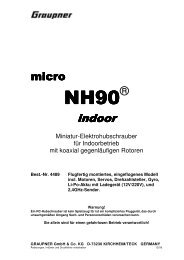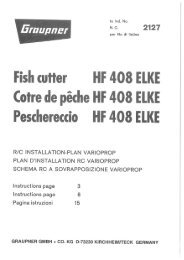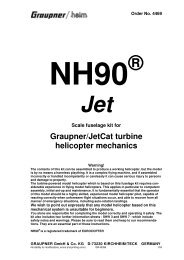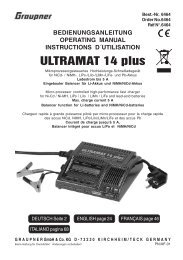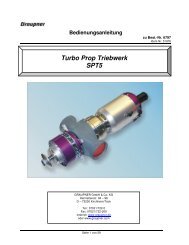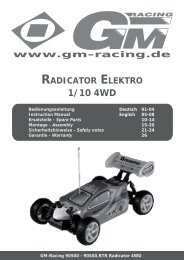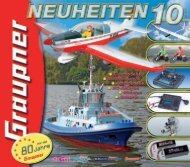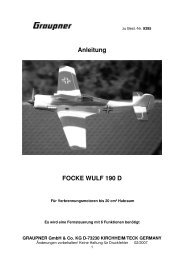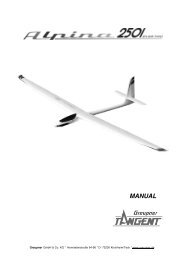Download - Graupner
Download - Graupner
Download - Graupner
Create successful ePaper yourself
Turn your PDF publications into a flip-book with our unique Google optimized e-Paper software.
ASSEMBLY INSTRUCTIONS<br />
Order No. 9352<br />
LEKI EXTRA 330SC<br />
RC aerobatic model for 2 LiPo cells<br />
This model requires a HoTT radio control system<br />
with at least four functions<br />
GRAUPNER GmbH & Co. KG D-73230 KIRCHHEIM/TECK GERMANY<br />
Modifications reserved! No liability for printing errors! 10/2011<br />
- 1 -
It is essential to read and observe the safety notes in the appendix to these instructions. If you<br />
ever pass this model on to another person, be sure to include the complete assembly<br />
instructions.<br />
Introduction<br />
The LEKI EXTRA 330SC is a superbly manoeuvrable RC aerobatic model, and its<br />
compact dimensions make it easy to transport. The small dimensions should not<br />
mislead you into thinking that the assembly and operation of the model do not require<br />
any model aircraft experience. The model is very highly pre-fabricated. Nevertheless<br />
the construction stages described in these instructions must be carried out with great<br />
care to ensure that the model can be used safely and successfully. The all-up<br />
weight must not exceed 1000 g.<br />
RC system accessories (not included)<br />
You will need the items listed below in order to complete and operate the model.<br />
COMPUTER SYSTEM MX-16 GRAUPNER HoTT 2.4 GHz Order No.33116<br />
Transmitter charge lead Order No.3022<br />
Brushless motor COMPACT 345Z Order No.7738<br />
ELECTRIC PROP 10x5” Order No.1326.10x5<br />
GRP propeller spacer Order No. 197.60<br />
COMPACT CONTROL 45 Order No.7224<br />
LiPo 2/1600 7.4 V/1.6 Ah Order No.7634.2<br />
G 3.5 charge lead Order No.2970.L<br />
ULTRAMAT 16 S battery charger Order No.6468<br />
Servo DES 476 BB (5 required) Order No. 7915<br />
Servo extension lead 100 mm (2 required) Order No.3935.11<br />
Servo extension lead 180 mm (2 required) Order No.3935.18<br />
Hose binders 102 mm Order No. 1521.52<br />
Hose binders 188 mm Order No. 1005<br />
Hook-and-loop cable ties Order No. 1587<br />
Tools and adhesives required (not included)<br />
Balsa knife Order No.980<br />
Quick-drying glue Order No.5821<br />
Activator for quick-drying glue Order No.953.150<br />
UHU ALL PURPOSE ADHESIVE Power Order No.1096<br />
You will also need the following items: Philips screwdriver, open-end spanner SW 12,<br />
flat-nose pliers, wire cutter, drill Ø 1.6, Allen wrenches SW 1.5 and SW 2.5 mm,<br />
soldering gun and solder, hair dryer, sandpaper, geometric protractor, overhead<br />
marker, transparent tape, wood pulp paper, protective gloves, safety glasses.<br />
Assembly instructions<br />
Please read these building instructions completely before you start building, so that<br />
you have a clear idea of the sequence required. Before each stage, identify all the<br />
parts, tools and adhesives you will need, and have them ready. When working,<br />
always lay the parts on a clean, smooth surface, or a layer of foam material. Unless<br />
the instructions specifically state otherwise, use quick-drying glue with activator as<br />
adhesive. The best method is to apply glue to one face, then spray activator on the<br />
GRAUPNER GmbH & Co. KG D-73230 KIRCHHEIM/TECK GERMANY<br />
Modifications reserved! No liability for printing errors! 10/2011<br />
- 2 -
opposite face. Make sure that no residual adhesive gets on your hands or on the<br />
surface of the model. Immediately wipe of excess adhesive with wood pulp paper.<br />
Caution:<br />
Cyano-acrylates must not come into contact with any part of your body or the<br />
eyes. For this reason, we recommend that you wear protective goggles when<br />
using this material. Store the adhesive out of the reach of children. For safety<br />
reasons, use only the adhesive mentioned above. Please observe the operating<br />
instructions and safety notices for the respective accessories<br />
The wing<br />
First apply adhesive (UHU ALL PURPOSE ADHESIVE Power) to the inserted aileron<br />
hinges and push up the aileron until there is a gap of about 1 mm. After waiting for it<br />
to dry, check whether the aileron is secure.<br />
Unscrew the servo cover from the wing and fit in the servo. Separate the excess<br />
levers and drill the outermost hole of the servo lever to Ø 1.6 mm. Put the servo into<br />
the neutral position, attach the servo level vertically, and screw it tight. Use cyanoacrylate<br />
to glue the servo to the respective attachment tab.<br />
Insert a string to pull the servo lead carefully into the wing. Screw on the servo cover<br />
and make the aileron connection. Connect the pushrods and glue in the horn of the<br />
aileron. Note: If you want to do extreme flight manoeuvres, you should use the longer<br />
servo levers that are also included with the servo.<br />
GRAUPNER GmbH & Co. KG D-73230 KIRCHHEIM/TECK GERMANY<br />
Modifications reserved! No liability for printing errors! 10/2011<br />
- 3 -
The figure shows the assembled aileron linkage. Please note that the servo level<br />
length should be at least 12 mm to keep the clevis from colliding with the wing.<br />
The figure shows the servo lead exiting at the wing root. Later, use the CRP tube Ø<br />
8x280 mm to push the halves of the wing onto the fuselage.<br />
Fuselage and tail group<br />
First place the motor spindle, motor mount, and locking ring onto the motor; these<br />
parts are included as accessories in the package for Order No. 7738.<br />
The figure shows the individual parts for the motor spindle and motor mount; tighten<br />
all screws.<br />
The figure shows the motor with attached motor mount and motor spindle. Separate<br />
the motor leads and remove about 5 mm of insulation. Apply solder to the ends of all<br />
leads and then solder on the G 3.5 connectors (included with Order No.7738).<br />
Insulate the connector shaft with the heat-shrink sleeves (included with Order<br />
No.7738) . Use a hair dryer to shrink the heat-shrink sleeve. Then do a test run of<br />
GRAUPNER GmbH & Co. KG D-73230 KIRCHHEIM/TECK GERMANY<br />
Modifications reserved! No liability for printing errors! 10/2011<br />
- 4 -
the motor. Viewed in flight direction, the motor should rotate to the right; if this is not<br />
the case, switch any two of the leads and re-insert.<br />
Using the 4 M 3x10 mm and the washers and locking rings shown, screw the motor<br />
in tight.<br />
Place the GRP propeller spacer onto the propeller, enlarge the cut-outs in the spinner<br />
cap to fit the propeller, separate the two short pins on the spinner back plate, so that<br />
the spinner cap fits and can be pushed on without any stress.<br />
GRAUPNER GmbH & Co. KG D-73230 KIRCHHEIM/TECK GERMANY<br />
Modifications reserved! No liability for printing errors! 10/2011<br />
- 5 -
Now adjust the motor with the moveable motor bulkhead so that spinner and motor<br />
bonnet match up. When everything fits, attach the motor bonnet with tape. Keep 1<br />
mm of play between the spinner back plate and fuselage.<br />
The motor bonnet, which is still held in place by tape, is now screwed into place with<br />
four Ø 2.2x6 mm metal screws as shown in the illustration. Pre-drill at Ø 1.6 mm.<br />
Glue the motor bulkhead in place through the cooling air intakes.<br />
Remove the motor bonnet again, glue in the 8x8 mm chamfer strips and completely<br />
glue in the motor bulkhead from the front as well.<br />
GRAUPNER GmbH & Co. KG D-73230 KIRCHHEIM/TECK GERMANY<br />
Modifications reserved! No liability for printing errors! 10/2011<br />
- 6 -
Use UHU ALL PURPOSE ADHESIVE Power to glue in the rudder hinges of the<br />
tailplane and vertical stabilisers in accordance with the method already described.<br />
Use a geometric protractor and overhead marker to exactly mark the midline of the<br />
tailplane; then area to be glued to the fuselage. Use the hot tip of a soldering gun to<br />
cut through the covering sheet, and pull it off.<br />
Slide the tailplane into the fuselage exactly centred and glue it from the inside as<br />
shown. For the lowest rudder hinge of the rudder cut a slit in the fuselage; then push<br />
on the vertical stabiliser as well. First try this procedure without any adhesive. Above<br />
all, make sure you do not use activator for the gluing process.<br />
GRAUPNER GmbH & Co. KG D-73230 KIRCHHEIM/TECK GERMANY<br />
Modifications reserved! No liability for printing errors! 10/2011<br />
- 7 -
The rudder is controlled by control leads on two sides. The figure shows the double<br />
rudder horn and the clevis with threaded bushing on the servo side. Insert the control<br />
leads into the fuselage and secure them as shown with the pressed-together<br />
bushing.<br />
The figure shows the central rudder servo with the inserted control leads, which are<br />
adjusted and tightened using the threaded bushings. For this purpose, glue in the<br />
rudder horn and drill a Ø 1.6 mm hole in the servo lever arm. Place rubber grommets<br />
on the servo, insert the hollow rivets from below, and screw in the servo. All servo<br />
attachment elements are included with the respective servos.<br />
The two-part elevator is controlled by two separate servos. The figure shows the left<br />
elevator servo. Make sure that the two rudder horns are glued in exactly the same.<br />
Note: If you do not wish to fly any extreme flight manoeuvres, you should reduce the<br />
rudder deflection in accordance with the transmitter setting.<br />
GRAUPNER GmbH & Co. KG D-73230 KIRCHHEIM/TECK GERMANY<br />
Modifications reserved! No liability for printing errors! 10/2011<br />
- 8 -
The figure shows the right elevator servo the control already attached.<br />
Undercarriage and cockpit canopy<br />
The figure shows the undercarriage struts, the wheel covers, and the elements for<br />
attaching the wheel and wheel cover to the undercarriage struts.<br />
First trim the transitional cowling to the fuselage and slide it onto the undercarriage<br />
struts; check the fit to the fuselage.<br />
The figure shows the individual parts of the wheel axle and left wheel cover with the<br />
3x9 mm elongated hole. Glue the two plywood spacers flush with the axle, slide on<br />
the wheels, screw on the M 3 nut, and insert into the wheel cover.<br />
GRAUPNER GmbH & Co. KG D-73230 KIRCHHEIM/TECK GERMANY<br />
Modifications reserved! No liability for printing errors! 10/2011<br />
- 9 -
The figure shows the completed wheel with cover, which is now firmly connected to<br />
the undercarriage strut by means of washer and M 3 nut. Align the two wheel covers<br />
exactly. When everything fits, secure the connections with adhesive. Caution: Do not<br />
get any adhesive on the wheel hub.<br />
The figure shows the completely assembled and attached undercarriage, which is<br />
screwed on with three M 3 screws, including locking rings. Do not remove the<br />
covering sheet to do this; just puncture it for the screws.<br />
Put the fuselage fairing in place, glue in the pilot, and glue on the cockpit canopy with<br />
UHU ALL PURPOSE ADHESIVE Power, hold in place with tape.<br />
Note: If you value particularly agile flight characteristics, you can do without the bust<br />
of the pilot in order to save about 30 g in all-up weight.<br />
GRAUPNER GmbH & Co. KG D-73230 KIRCHHEIM/TECK GERMANY<br />
Modifications reserved! No liability for printing errors! 10/2011<br />
- 10 -
Decals<br />
Cut out the individual decals and name placards and apply them to the model as<br />
shown in the illustrations on the kit box lid or in the following two-page view.<br />
Two-page view<br />
The original LEKI EXTRA 330SC at Hahnweide 2009.<br />
GRAUPNER GmbH & Co. KG D-73230 KIRCHHEIM/TECK GERMANY<br />
Modifications reserved! No liability for printing errors! 10/2011<br />
- 11 -
Installing the receiver and LiPo battery<br />
The first step is to connect the servo leads to the receiver; we recommend the<br />
following sequence: speed controller to socket 1, left aileron servo to socket 2<br />
(extension cable 100 mm), left elevator servo to socket 3 (extension cable 180 mm),<br />
rudder servo to socket 4, right aileron servo to socket 5 (extension cable 100 mm),<br />
right elevator servo to socket 6 (extension cable 180 mm). Now use the radio<br />
controller to test all the functions. Caution: After closing the G3.5 connector, the<br />
motor can start; do not touch the propeller!<br />
The figure shows the speed controller and GR-12 HoTT receiver held in place by<br />
hose binders; the LiPo battery is held in place by hook-and-loop cable ties. The photo<br />
also how each wing half is secured by an M 3 screw.<br />
Rudder deflections<br />
The following rudder deflections are recommended, but can be changed as desired.<br />
Ailerons 25 mm in each direction, elevators 25 mm in each direction, rudder 50 mm;<br />
all measured at the inboard or bottom edge of the rudder.<br />
Balancing<br />
Check the balance with the model in ready to fly condition, meaning with the LiPo<br />
connected. The centre of gravity is 72 mm from the leading edge of the wing. Adjust it<br />
by moving the LiPo battery as needed. Check the centre of gravity by simply<br />
supporting the model under the wing on two fingers. The model should balance level<br />
at the point indicated.<br />
Flying<br />
Fly the model for the first time with rudders in the neutral position on a day with little<br />
or no breeze. A smooth runway into the wind is ideal for a ground start. If no runway<br />
is available, start the model by means of a hand start into the wind. Use minimal<br />
aileron and elevator corrections to keep the model in a straight climb. The fine trim is<br />
done via the trim slider below or next to the joysticks. Always land the model flying<br />
directly into wind, with the motor idling but not switched off. Just before touch-down<br />
reduce air speed through careful use of up-elevator. Always land the model flying into<br />
GRAUPNER GmbH & Co. KG D-73230 KIRCHHEIM/TECK GERMANY<br />
Modifications reserved! No liability for printing errors! 10/2011<br />
- 12 -
the wind.<br />
Here at GRAUPNER Modellbau, we hope you have many enjoyable flights with your<br />
new model, the<br />
LEKI EXTRA 330SC<br />
GRAUPNER GmbH & Co. KG D-73230 KIRCHHEIM/TECK GERMANY<br />
Modifications reserved! No liability for printing errors! 10/2011<br />
- 13 -
Safety notes<br />
Valid third-party insurance must be obtained before you operate any model aircraft; this is now<br />
a legal requirement.<br />
Before you attempt to assemble and fly the model, it is essential to carefully read all the<br />
assembly and operating instructions. You alone are responsible for the safe operation of your<br />
RC model aircraft. Young persons should only be permitted to build and operate this model<br />
under the instruction and supervision of an adult who is aware of the hazards involved in this<br />
activity.<br />
In legal terms, our models are classed as aircraft and as such are subject to legal regulations<br />
and restrictions which must be observed. Our brochure “Modellflugrecht, Paragrafen and<br />
mehr” (Model Aviation Law, Legal Requirements and more) is available under Order No.<br />
8034.02, and contains a summary of all these rules. Your local model shop should have a copy<br />
which you can read. In addition, you must also observe postal regulations for the remote<br />
control system. You will find more information on this subject in the operating instructions<br />
supplied with your radio control system.<br />
Be sure to use only those parts included in the kit, together with other genuine <strong>Graupner</strong><br />
accessories and replacement parts as recommended expressly by us. Even if you change a<br />
single component you can no longer be sure that the system will work reliably, and such<br />
changes also invalidate your guarantee.<br />
Take care to avoid short-circuits and reversed polarity.<br />
The high energy density of LiPo batteries involves a risk of fire and even explosion.<br />
A radio-controlled model aircraft can only work properly and fulfil your expectations if it is built<br />
very carefully and in accordance with the assembly instructions. To avoid injuring people and<br />
damaging property, it is essential to be careful and painstaking at all stages of operating your<br />
model. Nobody would climb into a full-size glider and attempt to fly it without undergoing<br />
suitable training beforehand. Successful model flying is also only possible with suitable<br />
training and plenty of practice.<br />
As manufacturers, however, we are not in a position to influence the way you build and operate<br />
your RC model aircraft. All we can do is expressly point out the hazards involved in this<br />
activity, and for this reason we reject any liability.<br />
We suggest that you ask an experienced model flyer for help, or join a model club or model<br />
flight training school. Your local model shop and the specialist magazines are excellent<br />
sources of information. It is always best to join a club and fly at the approved model flying site.<br />
Adhesives contain materials which may be hazardous to health under certain circumstances.<br />
Read and observe the notes and warnings supplied by the manufacturer of these materials.<br />
The operator of the model must be in full possession of his or her bodily and mental faculties.<br />
As with car driving, operating a model aircraft under the influence of alcohol or drugs is not<br />
permissible under any circumstances.<br />
If there are passers-by or spectators at your flying site, make sure that they are aware of the<br />
dangers inherent in your activity before you start the motor, and insist that they keep a safe<br />
distance away.<br />
Always keep a safe distance from people and objects when flying; never fly low over people’s<br />
heads, and never fly directly toward them!<br />
Models should only be flown in a temperature range of -5° to +35 ° C. Extreme temperatures can<br />
lead to changes in battery capacity and material characteristics, weakened glued joints, and<br />
other unwanted effects.<br />
GRAUPNER GmbH & Co. KG D-73230 KIRCHHEIM/TECK GERMANY<br />
Modifications reserved! No liability for printing errors! 10/2011<br />
- 14 -
All model fliers should take care to ensure that the public safety, especially that of people and<br />
property, as well as orderly flying operations, are not endangered or disturbed.<br />
Never operate your model aircraft close to high-tension overhead cables, industrial sites,<br />
residential areas, public roads, squares, school playgrounds, public parks or sports grounds et<br />
cetera.<br />
Pre-flight check<br />
Check all the model’s working systems before every flight: switch on the transmitter followed<br />
by the receiving system. Extend or the transmitter aerial, then check that all the model’s<br />
control surfaces are at neutral (centre), work properly, and deflect in the proper direction.<br />
Repeat the check with the motor running, while someone holds the model securely for you.<br />
If you are a relative beginner to model flying, we strongly recommend that you ask an<br />
experienced helper to support and help you during the first few flights.<br />
Don’t ignore our warnings. They refer to materials and situations which, if ignored, can result<br />
in fatal injury or permanent damage.<br />
Propellers and other rotating parts that are powered by a motor constitute a constant hazard<br />
and represent a real risk of injury. Do not touch them with any part of your body. For example,<br />
a propeller spinning at high speed can easily cut your finger.<br />
Keep well clear of the rotational plane of the propeller! You never know when some part may<br />
come loose and fly off at high speed, hitting you or anybody else in the vicinity. This can easily<br />
result in serious personal injury. Ensure that no other object can come into contact with the<br />
revolving propeller.<br />
Make sure that no object is blocking the propeller.<br />
Every time you intend to operate your model, check carefully that it and everything attached to<br />
it (e.g. propeller, gearbox, RC components, et cetera) are in good condition and undamaged. If<br />
you find a fault, do not fly the model until you have corrected it.<br />
Before you switch the radio system on, always make sure that your frequency is vacant. Radio<br />
interference caused by unknown sources can occur at any time without warning. If this should<br />
happen, your model will be uncontrollable and completely unpredictable. Never leave your<br />
radio control system unattended, as another person might pick it up and try to use it.<br />
Do not switch on the electric motor unless you are sure that there is nothing in the rotational<br />
plane of the propeller. Electric motors with the propeller attached should only be run when<br />
firmly mounted.<br />
You should always be aware of the model’s position and attitude throughout each flight, so<br />
that you can execute control and avoidance manoeuvres. If you detect a control problem or<br />
interference during a flight, immediately land the model for the sake of safety. Models must<br />
always give way to full-size aircraft. Take-off and landing strips should be free of people and<br />
other obstacles.<br />
To ensure proper operation of your RC system, make sure that the batteries are kept fully<br />
charged.<br />
Never use batteries which are hot, faulty or damaged. At all times heed the instructions<br />
provided by the battery manufacturer.<br />
Before each flight check that all functions on the model aircraft are working correctly, and that<br />
the radio control system is in good order and operating at full range.<br />
Note that the motor control (throttle) function on the transmitter must always be moved to the<br />
OFF position as the first stage in preparing for a flight. To keep the electric motor from starting<br />
unexpectedly, always switch the transmitter on first, and only then the receiving system. Also,<br />
always switch the receiving system off first and only then the transmitter.<br />
GRAUPNER GmbH & Co. KG D-73230 KIRCHHEIM/TECK GERMANY<br />
Modifications reserved! No liability for printing errors! 10/2011<br />
- 15 -
Check that the control surfaces follow the movement of the transmitter joysticks.<br />
After each session, remove the battery from the model, discharge it to the recommended level,<br />
and store it in a safe place, well out of the reach of children, at a temperature in the range<br />
about +5°C to +25°C.<br />
These notes are intended only to make you aware of the many dangers and hazards that can<br />
arise if you work carelessly or irresponsibly. If you take reasonable care, model flying is a<br />
highly creative, instructive, enjoyable and relaxing pastime.<br />
Manufacturer’s declaration:<br />
If material defects or manufacturing faults should arise in a product distributed by us in the<br />
Federal Republic of Germany and purchased by a consumer (§ 13 BGB), we, <strong>Graupner</strong> GmbH &<br />
Co. KG, D-73230 Kirchheim/Teck, Germany, acknowledge the obligation to correct those<br />
defects within the limitations described below.<br />
The consumer is not entitled to exploit this manufacturer’s declaration if the failure in the<br />
usability of the product is due to natural wear, use under competition conditions, incompetent<br />
or improper use (including incorrect installation), or external influences.<br />
This manufacturer’s declaration does not affect the consumer’s legal or contractual rights<br />
regarding defects arising from the purchase contract between the consumer and the vendor<br />
(dealer).<br />
Extent of the guarantee<br />
If a claim is made under guarantee, we undertake at our discretion to repair or replace the<br />
defective goods. We will not consider further claims, especially for reimbursement of costs<br />
relating to the defect (e.g. installation / removal costs) and compensation for consequent<br />
damages unless they are allowed by statute. This does not affect claims based on legal<br />
regulations, especially according to product liability law.<br />
Guarantee requirements<br />
The purchaser is required to make the guarantee claim in writing, and must enclose original<br />
proof of purchase (e.g. invoice, receipt, delivery note) and this guarantee card. He must send<br />
the defective goods to us at his own cost, using the address stated above.<br />
The purchaser should state the material defect or manufacturing fault or the symptoms of the<br />
fault in as accurate a manner as possible so that we can check whether our guarantee<br />
obligation is applicable.<br />
The goods are transported from the consumer to us and from us to the consumer at the risk of<br />
the consumer.<br />
Duration of validity<br />
This declaration only applies to claims made to us during the claim period as stated in this<br />
declaration. The claim period is 24 months from the date of purchase of the product by the<br />
consumer from a dealer in the Federal Republic of Germany (date of purchase). If a defect<br />
arises after the end of the claim period, or if the evidence or documents required according to<br />
this declaration in order to make the claim valid are not presented until after this period, then<br />
the consumer forfeits any rights or claims from this declaration.<br />
Limitation by lapse of time<br />
If we do not acknowledge the validity of a claim based on this declaration within the claim<br />
period, all claims based on this declaration are barred by the statute of limitations after six<br />
months from the time of claim, but not before the end of the claim period.<br />
Applicable law<br />
This declaration, and the claims, rights and obligations arising from it, are based exclusively<br />
on the applicable German Law, without the norms of international private law, and excluding<br />
UN retail law.<br />
GRAUPNER GmbH & Co. KG D-73230 KIRCHHEIM/TECK GERMANY<br />
Modifications reserved! No liability for printing errors! 10/2011<br />
- 16 -



